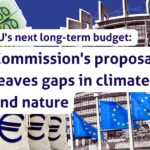EU industrial strategy is in a period of frenetic activity, especially as EU industry is affected by multiple converging crises resulting in increased costs and supply chain provisioning difficulties. This is the case for industry in many other countries, so is not specific to the EU. However, there is a clear risk that some EU decision-makers’ reactions to the current crisis-torn context risk abandoning critical democratic dialogue about a strategic approach to industrial transformation and instead rush to present hasty responses, often with a limited focus on unleashing vast sums of public money to big polluters.
This week should have seen meetings of the Industrial Forum and the High Level Roundtable (HLRT) on chemicals, where CAN Europe would have been present as members of both bodies. While the HLRT did meet, the Industrial Forum was postponed yet again. This is only the latest disruption in a long sequence of events undermining what was meant to be a discussion of a comprehensive strategy for the transformation of European energy-intensive industries – particularly cement, chemicals and steel sectors.
Work on this wider pathway began in 2020, but was put ‘on hold’ by late 2022 due to these sectors being hard hit by covid pandemic lockdowns, energy price hikes and the fall-out from Russia’s invasion of Ukraine.
In the meantime, only the chemicals strategy which was originally meant to be a chemicals ‘chapter’ of this wider transition pathway was discussed separately in the meeting of the HLRT along two separate items: the chemicals strategy for sustainability and the chemicals transition pathway. The chemicals strategy for sustainability is the overarching political document setting out objectives on chemicals policy to help the delivery of European Green Deal objectives relating to climate, biodiversity and zero-pollution. The chemicals pathway is a document meant to provide more detail on how specific ‘industrial ecosystems’ can achieve the green and digital transitions for industry to contribute to those same EGD objectives.
Late last year, in a side-meeting of the Forum where the chemicals chapter was being discussed, CAN Europe called for work to restart on the energy-intensives’ pathway. In response, a European Commission official said that the pathway was ‘abandoned’. Instead of the transition pathways, the Commission’s Directorate for Internal Market, Industry, Entrepreneurship and SMEs, DG GROW, started to refer to a 2019 ‘Masterplan’ document. This document however is not a pathway and pre-dates the European Green Deal, the two EU industrial strategies produced since 2020, and subsequent political decisions of clear relevance to the sectors.
To date, DG GROW has not communicated officially with Forum members about any of this. Publication of the chemicals pathway on 27 February confirmed this reverting back to the Masterplan document, written clearly in the document’s text. At the same time, the Commission prepares developments such as on a new net-zero industry act aka ‘Green Deal Industrial Plan’, neither communicated in its 2023 work programme nor discussed with members of the Industrial Forum. It also is pushing policy makers to contemplate increasingly large sums of money to be given to these same sectors (and others), with no clarity on any conditions attached to the money, as flagged by CAN Europe.
A quick scan of recently announced public funds shows billions of Euros provided to energy-intensive industries most recently as ‘emergency’ measures due to increased energy costs. The last State Aid Scoreboard shows a ‘record’ €384bn in state aid in 2020. According to the European Commission, nearly half of the total amount involves German aid as companies were hit hard by the loss of Russian gas. In just the past few months, the German government provided a further €49bn to industries affected by the cut-off of Russian gas supply. Specifically on chemicals, the government gave BASF, the world’s biggest chemicals company, €134m to switch its mega-site at Ludwigshafen from gas to renewable hydrogen. Three weeks later, BASF announced it would downsize ‘permanently’ in Europe, citing high energy prices and the EU’s Chemical Strategy for Sustainability as the reasons. BASF’s CEO cited regulatory uncertainties stemming from the chemicals strategy for sustainability, which along with the EU Green Deal, are ‘putting parts of its portfolio at risk and leading to higher costs’.
Yet, regulatory certainty is precisely what the chemicals strategy is aiming to provide. Regulatory certainty that investment bodies call for as part of de-risking of private investment to industry.
At yesterday’s meeting where the Commission (ENV & GROW) presented the chemicals pathway , CAN Europe highlighted the importance of the chemicals strategy for sustainability, of bringing forward the planned and delayed REACH revision, and of a coherent approach to chemicals in the Ecodesign of Sustainable Products Regulation so it can effectively reduce product environmental and carbon footprints. This latter clearly needs to address chemicals for their impacts on environmental and human health as well as on the climate, and it also needs to address plastic as a priority product.
This emerging trend of EU industrial policy focusing more and more on bailing out companies in ‘emergency’ situations threatens to become a costly habit, but can’t become a normalised approach especially as we see constantly worsening climate change and extreme weather events as part of an increasingly volatile and uncertain global situation. This approach, which builds on policy development without participation and consultation of civil society, is also destroying trust and disregarding democratic, transparent and accountable processes. It is vital that this back-door policy-making without civil society oversight stops and that any approach to industrial policy much better reflects public interest and sufficient ambition levels.
References:
-
Politico pro alert 21 December 2022: Germany wins Commission approval for €49B state aid package
-
Chemical Watch magazine, 10 November 2022: “BASF says EU chemicals strategy a factor in decision to cut costs”;
-
Financial Times article, 26 October 2022: “BASF to downsize ‘permanently’ in Europe”.



